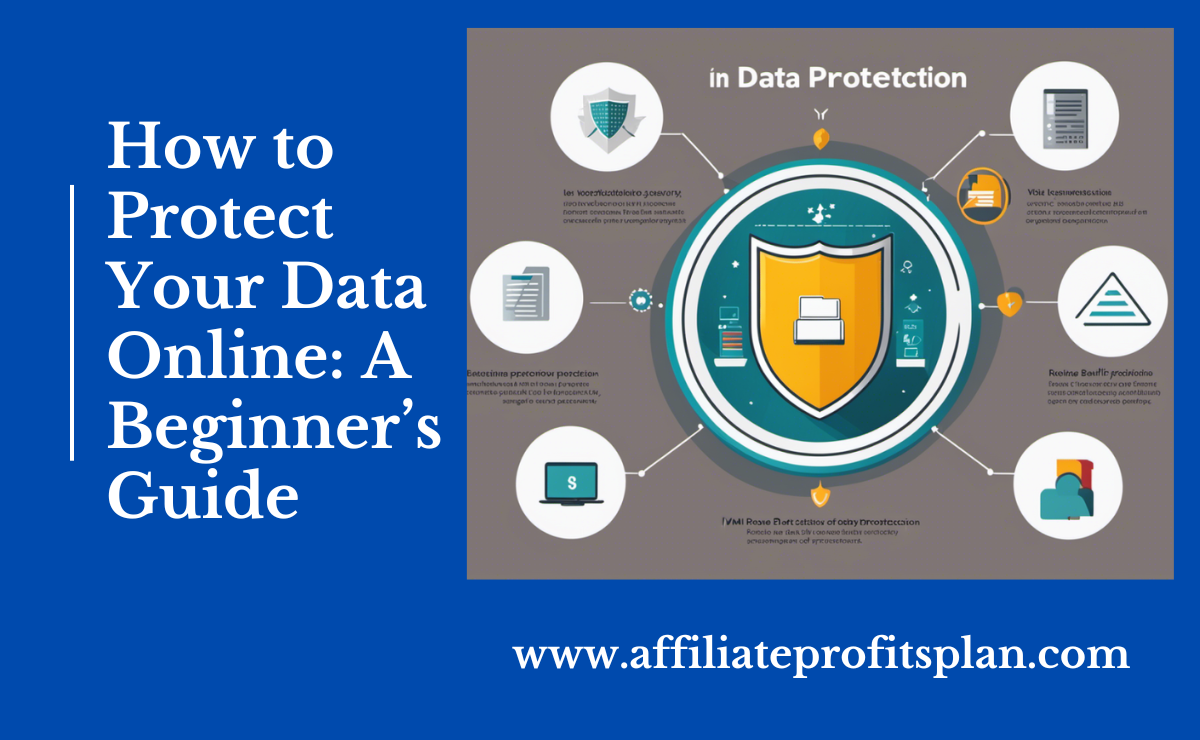Welcome to my article “How to Protect Your Data Online: A Beginner’s Guide.” In today’s digital world, protecting your data online is as essential as locking your front door—or at least, it should be. After all, you wouldn’t leave your wallet on the street with a note that says, “Help yourself!” But when we reuse weak passwords, click on sketchy links, or overshare on social media, we’re basically doing just that—leaving the door wide open for hackers, scammers, and other internet mischief-makers.
The truth is, the internet can be a bit like the wild west. There are good guys, bad guys, and a whole lot of people trying to sell you things you don’t need. For beginners, keeping your personal data safe can feel overwhelming—VPNs, firewalls, phishing scams, oh my! But don’t worry, this guide isn’t about scaring you into becoming a digital hermit. It’s about helping you take simple, effective steps to make your online life safer without sacrificing convenience (or your sanity).
By the end of this guide, you’ll know how to outsmart the bad guys, secure your gadgets, and maybe even look a little tech-savvy while you’re at it. Ready to transform your digital presence from “sitting duck” to “fortress of security”? Let’s get started—you’ve got data to protect, and we’ve got tips to share!
Access Our Proven Tested Formula for $50-$100 Daily Income – Watch This FREE Video >>

Understand the Basics of Online Data Protection
Let’s start with the basics: What is online data protection, and why does it sound like something only tech geniuses or secret agents worry about? The truth is, online data protection is simply the practice of keeping your personal information safe from prying eyes—whether those eyes belong to a hacker in a basement or a shady website asking for your credit card number in exchange for “free” puppy photos.
Here’s the deal: your data is valuable. We’re not just talking about your bank details or passwords—although those are gold mines for cybercriminals. Even seemingly harmless info, like your email address or favorite coffee shop, can be used to target you with scams, phishing emails, or ads for overpriced espresso machines. The more hackers know about you, the easier it is for them to trick you into giving away even more. It’s like feeding a stray cat—once you start, they’ll keep coming back for more.
So, how does this data theft happen? Some common methods include phishing scams (those fake emails that say “Your package is delayed—click here!”), unsecured websites (if the URL doesn’t start with “https,” run!), and weak passwords (if your password is still “123456” or “password,” we need to talk). Even using public Wi-Fi without protection can leave your personal data as exposed as a bad haircut in a bright room.
The good news? Protecting yourself doesn’t require a Ph.D. in cybersecurity. Understanding these basic risks is the first step to staying safe. Think of it like learning to spot a pickpocket in a crowded market. Once you know what to look for, you’re already one step ahead of the game—and the scammers.
Use Strong Passwords and Two-Factor Authentication
Passwords—the keys to our digital kingdoms. But let’s be honest, most of us have been guilty of using passwords that could be cracked by a toddler with a keyboard. If your password is still “qwerty” or “ilovedogs123,” we need to have a serious talk (and maybe an intervention). A strong password isn’t just a suggestion; it’s your first line of defense against hackers who would love nothing more than to stroll into your accounts like they own the place.
So, what makes a password strong? Think of it like building an unbreakable secret code. Use a mix of uppercase and lowercase letters, numbers, and special characters. “MyDogIsCute” might seem clever, but “Myd0g!sC#te?” is far harder to crack. Avoid obvious things like your name, birthdate, or favorite sports team—hackers are surprisingly good at guessing those. And whatever you do, don’t reuse passwords across multiple sites. Yes, it’s annoying, but imagine a hacker cracking your email password and then waltzing into your bank account. Not worth the risk, right?
Now, if managing a dozen different passwords sounds like a nightmare, meet your new best friend: a password manager. It’s like a vault that stores all your super-strong passwords, so you only have to remember one (just make sure that one is extra secure).
But even the best passwords aren’t perfect, which is where two-factor authentication (2FA) comes in. Think of 2FA as your digital bouncer. Even if someone steals your password, they’ll still need a second piece of information—like a code sent to your phone or a fingerprint scan—to get in. It’s an extra layer of security that turns a hacker’s job from “easy peasy” to “maybe I’ll try someone else.”
Bottom line: Strong passwords and 2FA aren’t just good ideas—they’re must-haves. Sure, they take a little extra effort, but so does locking your doors at night. And let’s face it, you wouldn’t leave your front door open with a sign that says, “Free stuff inside!” Your online accounts deserve the same level of protection.
Avoid Phishing Scams and Unsafe Links
Let’s play a game: You get an email that says, “URGENT: Your account has been compromised! Click here to secure it now!” Do you:
A) Panic and click the link faster than a Black Friday shopper, or
B) Calmly delete it and carry on with your day?
If you choose option A, congratulations—you’ve just been phished (hypothetically, of course). Phishing scams are the bread and butter of cybercriminals. They use fake emails, messages, or websites to trick you into handing over sensitive information like passwords, credit card numbers, or, in some cases, your soul (okay, maybe not that last one).
These scams often look alarmingly convincing, complete with official-looking logos, scary subject lines, and links that almost look legitimate. But don’t let them fool you—phishers are experts at preying on fear and urgency. Their goal is to make you react without thinking, which is why your first rule of thumb should always be: Stop. Think. Don’t click.
Access Our Proven Tested Formula for $50-$100 Daily Income – Watch This FREE Video >>
Here are a few tips to help you avoid falling for these sneaky traps:
- Check the sender’s email address. If it looks like a random jumble of letters and numbers (e.g., support12345@totallyrealbank.com), it’s probably a scam.
- Hover over links before clicking. If the URL doesn’t match the supposed sender or looks like gibberish, step away from the mouse.
- Watch for typos and weird formatting. Legit companies don’t usually send emails that look like they were written by someone who failed Spellcheck.
- Beware of “too good to be true” offers. No, you didn’t win a free iPhone from a contest you didn’t enter.
And let’s not forget about unsafe links outside of your inbox. Social media DMs, pop-up ads, and even Google search results can sometimes lead you to dangerous corners of the internet. A good rule of thumb? If it feels even slightly suspicious, don’t click it.
For an extra layer of protection, consider installing a browser extension or antivirus software that flags unsafe links. Think of it as your personal internet bodyguard, scanning for trouble before you accidentally step into it.
In the end, avoiding phishing scams and unsafe links is all about staying vigilant and a little skeptical. Remember, if something seems off, it probably is. And if you ever doubt the authenticity of a message, take a breath, do some research, and never, ever let panic drive your clicks. After all, you’ve worked too hard to build a secure online life to let a scammer ruin it with a fake email!
Secure Your Devices and Connections
Your smartphone, laptop, or tablet isn’t just a gadget—it’s a treasure chest filled with your personal information. Bank accounts, passwords, family photos, your favorite cat memes… everything is stored there. And if you don’t secure your devices, it’s like leaving that treasure chest wide open with a sign that says, “Help yourself, hackers!”
First things first: keep your devices updated. Yes, we know those software updates always pop up at the worst times (usually when you’re about to binge-watch your favorite show), but they’re crucial. Updates don’t just give you new emojis—they patch security holes that hackers love to exploit. So, the next time your device begs you to update, don’t hit “Remind me later” for the fifth time. Just do it.
Next up: protect your devices with strong passwords, PINs, or biometric locks. A simple swipe to unlock your phone might be convenient, but it’s also an open invitation to anyone who gets their hands on it. Use a unique passcode (no, not 1234 or your birth year) or better yet, enable fingerprint or facial recognition. It’s like giving your device its own little suit of armor.
Now let’s talk about your internet connection. Public Wi-Fi might feel like a lifesaver when you’re out and about, but it’s a hacker’s playground. Connecting to free Wi-Fi without protection is like shouting your personal information in a crowded coffee shop—someone is bound to listen. Instead, always use a Virtual Private Network (VPN) when browsing on public networks. A VPN encrypts your connection, making it nearly impossible for snoopers to spy on you. It’s like putting your internet activity in an invisibility cloak—take that, hackers!
Don’t forget about firewalls and antivirus software. Think of them as your digital bouncers, keeping the bad guys out. Firewalls monitor and control incoming and outgoing traffic, while antivirus programs detect and eliminate potential threats. Together, they form a security dream team for your devices.
Lastly, back up your data regularly. Sure, it sounds boring, but if your device ever gets hacked, lost, or hit with ransomware, you’ll be grateful you have a backup. Whether it’s an external hard drive or a cloud service, think of backups as your safety net—it’s always there to catch you when things go south.
Securing your devices and connections isn’t rocket science; it’s about taking simple steps to outsmart cybercriminals. By keeping your gadgets updated, locking them down, and using secure connections, you’ll make it much harder for hackers to access your personal treasure chest. And trust us, they’ll move on to easier targets, leaving your data safe and sound.
Be Mindful of What You Share Online
Sharing is caring, right? Sure—unless you’re oversharing online, in which case, sharing can be downright dangerous. Whether it’s a Facebook post, an Instagram story, or a tweet, the internet never forgets. And sometimes, what seems harmless in the moment can come back to haunt you faster than an embarrassing high school photo resurfacing at a family gathering.
Let’s start with social media. Posting about your vacation while sipping margaritas on a beach? That’s basically sending an open invitation to burglars: “Hey, I’m not home—help yourself!” Sharing your location in real time, tagging your favorite coffee shop, or even posting your child’s first day of school with the school name visible in the background—these all give away more about your life than you might realize. Cybercriminals are like detectives, piecing together small clues until they have the full picture.
But it’s not just the obvious stuff. Think about those fun quizzes that ask for your “superhero name” by combining your first pet’s name and the street you grew up on. Sounds innocent, right? Except those are the exact types of questions used for password recovery. So, while you’re laughing about being “Fluffy Elm Street,” hackers are inching closer to accessing your accounts.
Here’s a simple rule of thumb: If you wouldn’t want a stranger to know it, don’t share it online. Avoid posting personal details like your full name, phone number, home address, or even your birthday. Yes, we know birthdays are fun to celebrate, but do you really want hackers using that info to crack your security questions?
Also, think twice before sharing sensitive documents, even privately. That cute selfie with your driver’s license or plane ticket in hand? A dream come true for scammers who can use those details for identity theft.
Lastly, set your social media profiles to private and be selective about who you let into your digital circle. You wouldn’t invite just anyone into your home, so why give them access to your life online? Even then, remember: private doesn’t mean bulletproof. Anything you share online can still be screenshot, copied, or forwarded.
At the end of the day, being mindful about what you share online is all about striking a balance. It’s okay to share moments of your life—just do it wisely. Keep the cybercriminals guessing, the oversharing to a minimum, and your personal details safe. And hey, you’ll still have plenty of content to make your followers jealous without handing hackers the keys to your life.
Conclusion
Protecting your data online isn’t just for tech wizards or paranoid conspiracy theorists—it’s for everyone. In today’s digital age, where your personal information is as valuable as gold, staying safe online is less of an option and more of a necessity. Sure, it might feel like a hassle at times—strong passwords, constant updates, and double-checking every link before you click—but think of it like flossing. A little effort now saves you from a whole lot of pain later.
Access Our Proven Tested Formula for $50-$100 Daily Income – Watch This FREE Video >>
Remember, cybercriminals aren’t lurking in hoodies, typing furiously in dark basements (well, maybe some are). They’re creative, persistent, and always on the lookout for an easy target. By understanding the basics of online data protection, using strong passwords and two-factor authentication, avoiding phishing scams, securing your devices, and being mindful of what you share, you’re essentially putting a giant “No Trespassing” sign on your digital doorstep.
And hey, protecting your data doesn’t mean living in constant fear of the internet. It just means being smart and proactive. Think of it like locking your house before you leave or checking the expiration date on milk before you drink it. Simple habits that become second nature over time.
So, take a deep breath, update those passwords, enable that VPN, and stop clicking on sketchy links promising you a free cruise. The internet is a wonderful place, but only when you navigate it safely. You’ve got this—now go forth and surf with confidence!
Thanks a lot for reading my article on “How to Protect Your Data Online: A Beginner’s Guide” till the end. Hope you’ve helped. See you with another article.










